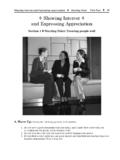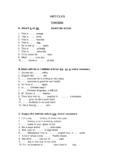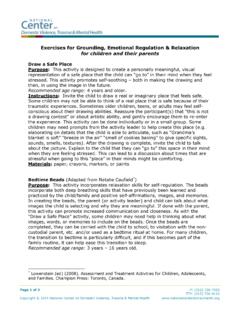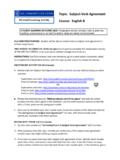Transcription of WAN Technologies CCNA 4 Labs and Study Guide
1 Page 1 of 6 WAN Technologies ccna 4 labs and Study Guide ISBN: 1-58713-173-0 WAN Technologies ccna 4 labs and Study Guide John Rullan Introduction WAN Technologies ccna 4 Lab Study Guide is a supplement to your classroom and laboratory experience with the Cisco Networking Academy Program. Specifically, this book covers the fourth course of the ccna curriculum. In order to be successful on the exam and achieve your ccna certification, you should do everything in your power to arm yourself with a variety of tools and training materials to support your learning efforts. This labs and Study Guide is just such a collection of tools.
2 Used to its fullest extent, it will help you learn the knowledge as well as practice the skills associated with the content area of of the ccna 4 WAN Technologies course. Specifically, this book will help you work on these main areas of ccna 4: Network Address Translation Dynamic Host Configuration Protocol ISDN dialer maps and profiles Frame Relay Goals and Methods The most important goal of this book is to help you prepare for either the ccna exam (640-801) or the ICND exam (640-811). Whether you are studying for the full exam or the second part of your ccna , passing either of these exams means that you not only have the required knowledge of the Technologies covered by the exam, but that you can plan, design, implement, operate and troubleshoot these Technologies .
3 In other words, these exams are rigorously application-based. In fact, if you view the main objectives for the ccna exam at , you will see the following four categories of objectives: Planning & Design Implementation & Operation Troubleshooting Technology Although Technology is listed last, a ccna student cannot possibly plan, design, implement, operate and troubleshoot networks without first fully grasping the technology. You should devote a significant amount of time and effort in the Study Guide section of each chapter learning the concepts and theories before applying them in the Lab Exercises. The Study Guide section offers exercises that help you learn the concepts and configurations crucial to your success as a ccna exam candidate.
4 Each chapter is slightly different and includes some or all of the following types of exercises: Vocabulary Matching and Completion Concept Questions Internet Research Page 2 of 6 WAN Technologies ccna 4 labs and Study Guide ISBN: 1-58713-173-0 The Lab exercise sections include all the online Curriculum labs , and brand new Comprehensive labs and Challenge labs . The Curriculum labs typically walk you through the configuration tasks step by step. The Comprehensive labs combine include many, if not all, of the configuration tasks of the Curriculum labs without actually providing you with the commands. The Challenge labs take this a step further, often only giving you a general requirement that you must implement fully without the details of each small step.
5 In other words, you must use the knowledge and skills you gained in the Curriculum labs from all four courses to successfully complete the Comprehensive and Challenge labs . In fact, you should not attempt the Comprehensive or Challenge labs until you have worked through all the Study Guide activities and the Curriculum labs . Avoid the temptation to work through the Comprehensive and Challenge labs by flipping back through the Curriculum labs when you are not sure of a command. Do not try to short-circuit your ccna training. You need a deep understanding ccna knowledge and skills to ultimately be successful on the ccna exam.
6 Who Should Read This Book? This book should be read by students completing the final course of the ccna curriculum. The challenge labs are designed to test your knowledge and ability to configure and troubleshoot routing protocols, switching concepts, and WAN protocols. Based on the author s experience in the classroom, extensive practical knowledge is necessary in order to pass the ccna certification. How This Book Is Organized Work through the Study Guide and Lab Exercises in the sequence they are presented. The sequence is designed to take you from a basic understanding of the knowledge through the full application and implementation of skills.
7 Specifically, Chapters 1 through 6 and Appendix A, include exercises and labs covering the following knowledge and skills: Chapter 1, Scaling IP Addresses This chapter describes how to conserve IP addresses and how to communicate across the Internet and WANs that span the globe. The chapter will go over NAT and PAT, two translation protocols for IP addresses, and DHCP, a method of auto-assigning IP addresses. The labs in this chapter will explain how IP addresses are translated with NAT and PAT as well as the process of DHCP. They will also help to understand the commands that are used to configure both. There is a Challenge lab included to test your comprehension of the chapter.
8 Chapter 2, WAN Technologies This chapter introduces much of the terminology and general concepts encountered in a Wide Area Network and lays the groundwork for an understanding of some of the more advanced concepts presented in later chapters. There are no labs in this chapter, only exercises to reinforce your understanding of the terminology and concepts. Chapter 3, PPP The third chapter of this book goes over the communication of individual links within the WAN that use certain types of encapsulation protocols. The protocols that are described in the chapter are HDLC and PPP. The challenge lab in this Page 3 of 6 WAN Technologies ccna 4 labs and Study Guide ISBN: 1-58713-173-0 chapter will test your ability to configure PPP and any previous concepts you have learned thus far in this book.
9 Chapter 4, ISDN and DDR The chapter on ISDN describes a cost-effective, need-basis WAN technology that may substitute for a T1 connection or just a step above a phone line. Dial-on Demand Routing is a method described in this chapter that makes ISDN cost-effective based on call-setup and termination. The labs in the chapter will test your knowledge configuring dialer maps and dialer profiles. Chapter 5, Frame Relay The chapter on Frame Relay explains how this packet-switched technology connects LANs across a cloud with the use of virtual circuits. The labs in this chapter will give you a feel on how to configure basic Frame Relay as well as two challenge labs that test all the skills you have learned up to this point.
10 Chapter 6, Introduction to Network Administration The final chapter in the fourth course of the ccna curriculum describes basic network administration concepts. It will also explain how to manage a network using different tools such as Simple Network Management Protocol. Upon completion of the exercises in this chapter, students should have a better understanding of different devices found on a LAN and the tools used to manage, test, and troubleshoot simple networks. Appendix A, Troubleshooting Questions and Lab exercise This appendix contains a practice challenge lab that tests your knowledge of all four courses of the ccna curriculum.


















